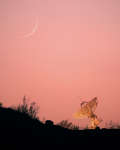Публикации
за август 2025 года.
|
Как образовалась эта необычная планетарная туманность? NGC 7027, которую называют туманностью Подушка или Летучий Ковер – одна из самых маленьких, ярких и обладающих необычной формой из всех известных планетарных туманностей. Скорость расширения NGC 7027 позволяет определить время начала расширения для земных наблюдателей – около 600 лет назад.
Полумесяц молодой Луны бывает нелегко найти на небе. Когда Луна видна как тонкий серп (молодой или старый), она всегда близка к Солнцу на небе планеты Земля. Однако на этом раннем вечернем пейзаже изящный освещенный Солнцем полумесяц хорошо виден, хотя небо еще яркое.
На этой космической картине доминирует диффузное свечение в линии Hα от эмиссионной области Sh2-27. Размер поля зрения – почти 3 градуса в богатом туманностями созвездии Змееносца в центральной области Млечного Пути. Темная вуаль...
На этом глубоком космическом пейзаже можно увидеть окруженные лучами звезды и похожие на привидения светящиеся облака. Изображение покрывает поле размером больше диска полной Луны в созвездии Пегаса. У ярких звезд, находящихся в нашей Галактике Млечный Путь, видны дифракционные лучи. Так проявляет себя крепление вторичного зеркала в телескопе-рефлекторе.
Что это за желтое пятно? Это молодая планета за пределами нашей Солнечной системы. Изображение, полученное Очень большим телескопом в Чили, запечатлело картину, похожую на нашу Солнечную систему во время ее формирования около 4.5 миллиардов лет назад.
Иногда небо удивляет вас. Чтобы увидеть больше звезд и тусклую туманность в звездном скоплении Плеяды (M45), используют длинные экспозиции. На этих экспозициях иногда появляются менее интересные объекты, которые не собирались запечатлеть и от которых избавляются при обработке.
В центре Крабовидной туманности находится нейтронная звезда размером с город с сильным магнитным полем, которая вращается вокруг своей оси 30 раз за секунду. Это – пульсар в Крабе – яркое пятнышко в середине газового вихря в центре туманности.
Как велика наша Луна? Если сравнивать с другими спутниками Солнечной системы, она находится на пятом месте по размеру, уступая спутнику Юпитера Ганимеду, спутнику Сатурна Титану и спутниками Юпитера Каллисто и Ио. Продолжая список, Луна больше спутника Юпитера Европы и спутника Нептуна Тритона. Луна больше карликовых планет Плутон и Эрис.
На этом цветном телескопическом изображении участка неба в "музыкальном" северном созвездии Лира видны тусклое внешнее гало и яркая кольцеобразная центральная область M57, известной как туманность Кольцо. Для современных астрономов M57 – хорошо известная планетарная туманность. Размер центрального кольца – около одного светового года.
На картинке запечатлено предрассветное небо ранним утром 12 августа. Большинство следов оставили метеоры из потока Персеиды, и вы легко можете найти их. Следы этих метеоров кажутся сходящимися в точке радианта ежегодного метеорного потока, расположенной в созвездии Персея и находящейся за верхним краем картинки. |
|









